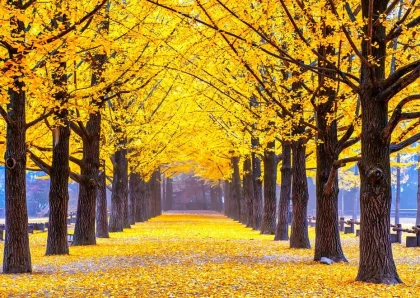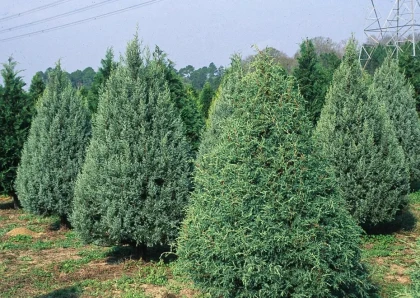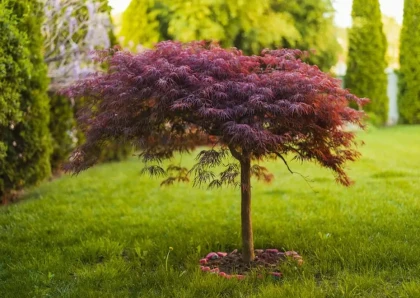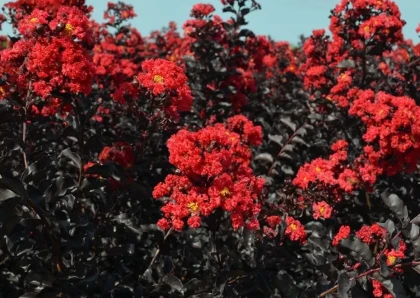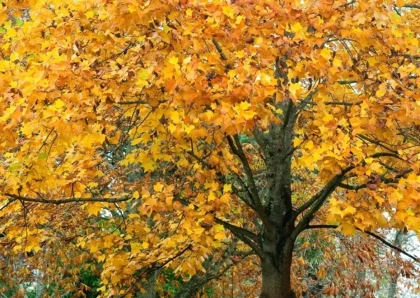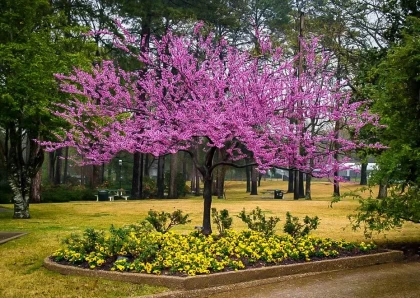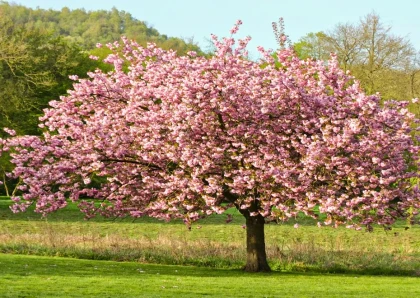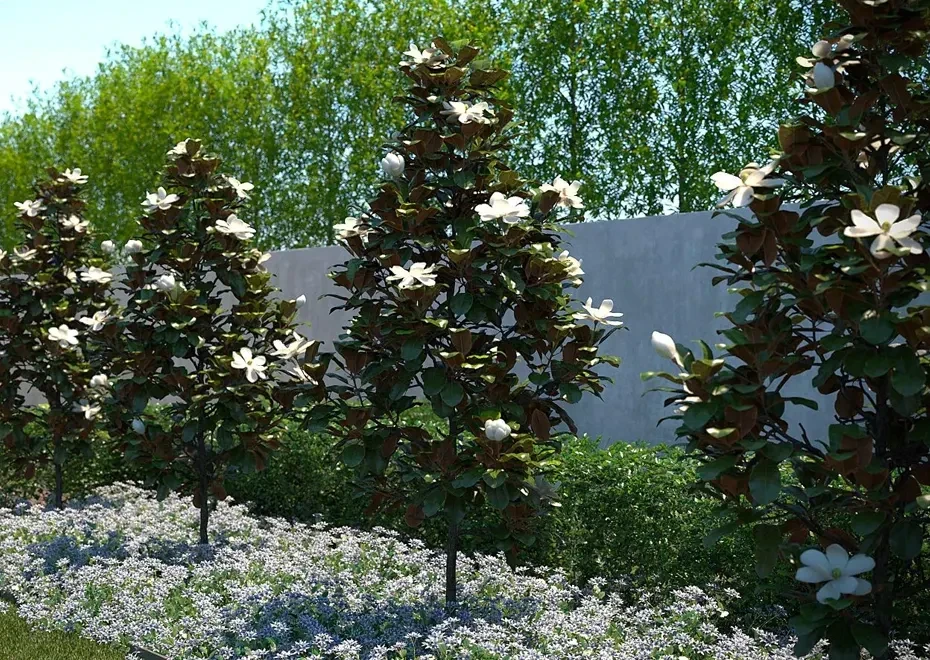
Little Gem Magnolia
Overview
History of the Tree
The Little Gem Magnolia (Magnolia grandiflora 'Little Gem') is a cultivar of the Southern Magnolia, a tree native to the southeastern United States. It was developed by the United States National Arboretum and introduced in the 1950s. The Little Gem Magnolia was specifically bred for its compact size and abundant, smaller-sized flowers, making it a popular choice for landscapes and urban environments.
Detailed Description of the Tree
The Little Gem Magnolia is a small to medium-sized evergreen tree that typically reaches a height of 20 to 30 feet (6 to 9 meters) with a spread of 10 to 15 feet (3 to 4.5 meters). It has an upright, pyramidal growth habit and dense, glossy green leaves with a leathery texture. The tree produces fragrant, creamy white flowers that are smaller in size compared to other magnolia varieties, typically around 4 to 6 inches (10 to 15 centimeters) in diameter. These flowers bloom from late spring to early summer and may continue sporadically throughout the year, adding beauty and fragrance to the landscape.
Types of This Tree
The Little Gem Magnolia is a specific cultivar within the Southern Magnolia species. While there are no distinct types of Little Gem Magnolia, there are other cultivars of Southern Magnolia that offer variations in size, flower color, and leaf characteristics. Some popular cultivars include Bracken's Brown Beauty, Edith Bogue, and Kay Parris, each with its own unique features.
Importance of This Tree
The Little Gem Magnolia holds several important qualities:
- Compact Size: Its smaller size makes it suitable for urban gardens, small yards, and tight spaces, where larger magnolia varieties may be impractical.
- Abundant Flowers: The Little Gem Magnolia produces an abundance of fragrant, creamy white flowers that add elegance and charm to the landscape. These flowers are attractive to pollinators and provide a lovely display.
- Evergreen Foliage: Unlike many deciduous trees, the Little Gem Magnolia retains its glossy green leaves throughout the year, providing year-round beauty and acting as an excellent screening or privacy tree.
How to Care for This Tree
To ensure the healthy growth of the Little Gem Magnolia, consider the following care guidelines:
- Plant the tree in a location that provides full to partial sunlight, as it thrives in well-lit areas but can tolerate some shade.
- Choose a well-drained soil that is rich in organic matter, as the tree prefers moist but not waterlogged conditions.
- Water the tree regularly, especially during dry periods, to keep the soil evenly moist. However, avoid overwatering, as excessive moisture can lead to root rot.
- Apply a layer of organic mulch around the base of the tree, extending to the drip line, to conserve moisture, suppress weeds, and regulate soil temperature.
- Prune the tree during late winter or early spring to maintain its shape, remove any dead or diseased branches, and promote better air circulation.
- Fertilize the tree in early spring with a slow-release, balanced fertilizer specifically formulated for trees to provide essential nutrients.
Benefits of the Tree
The Little Gem Magnolia offers several benefits:
- Compact and Versatile: Its smaller size makes it suitable for various landscapes, including urban gardens, courtyards, and smaller yards.
- Year-Round Interest: With its evergreen foliage and sporadic blooming throughout the year, the Little Gem Magnolia provides visual interest and beauty in every season.
- Fragrant Flowers: The tree produces fragrant, creamy white flowers that attract pollinators and add a delightful aroma to the surroundings.
- Screening and Privacy: The dense foliage of the Little Gem Magnolia makes it an excellent choice for creating natural screens or privacy barriers in the landscape.
How to Plant This Tree
Follow these steps to successfully plant a Little Gem Magnolia tree:
- Choose a planting location that receives full to partial sunlight and has well-drained soil.
- Dig a hole that is slightly wider and as deep as the root ball.
- Place the tree in the hole, ensuring the top of the root ball is level with or slightly above the ground surface.
- Backfill the hole with soil, gently firming it around the roots to eliminate air pockets.
- Water the tree thoroughly after planting and continue to water regularly during the first year to aid in establishment.
Different Types of Wood Products That Can Be Made From
The wood of the Little Gem Magnolia, like other magnolia varieties, is valued for its fine grain and stability. It is often used for cabinetry, furniture, interior trim, and decorative woodwork. The light color and smooth texture of the wood make it particularly desirable for creating elegant and visually appealing wood products.
Cons
While the Little Gem Magnolia is highly regarded, there are a few considerations to keep in mind:
- Environmental Sensitivity: The tree may be sensitive to harsh environmental conditions, such as extreme heat, drought, or prolonged periods of cold. Adequate care and protection during challenging conditions are essential for its well-being.
- Limited Cold Hardiness: The Little Gem Magnolia is hardy in USDA hardiness zones 7 to 9. In colder regions, it may require additional protection or may not survive harsh winter temperatures.
FAQs
1. Does the Little Gem Magnolia attract pollinators?
Yes, the fragrant flowers of the Little Gem Magnolia are attractive to various pollinators, including bees and butterflies.
2. Can the Little Gem Magnolia be grown in a container?
While it is possible to grow the Little Gem Magnolia in a container, it is important to select a large enough container to accommodate its root system and provide proper care, including regular watering and fertilization. Container-grown trees may have smaller sizes compared to those planted directly in the ground.
3. How tall does the Little Gem Magnolia grow?
The Little Gem Magnolia typically reaches a height of 20 to 30 feet (6 to 9 meters) with a spread of 10 to 15 feet (3 to 4.5 meters). However, actual size may vary depending on growing conditions and pruning practices.
4. When does the Little Gem Magnolia bloom?
The Little Gem Magnolia produces fragrant flowers from late spring to early summer, and sporadic blooming may occur throughout the year.
No listings available
Related Products
Questions & Answers
What do you want to know about this product?
Reviews (5)
MagnoliaEnthusiast88
xceeds Expectations
The Little Gem Magnolia Tree is a true gem in my garden. Its compact size, dark green foliage, and stunning blooms make it a standout. Highly recommended for small spaces!
GardenGuru21
Year-Round Elegance in a Magnolia Tree
The Little Gem Magnolia Tree has been a delightful addition to my landscape. Its evergreen foliage and charming blooms bring beauty and grace throughout the seasons.
UrbanArborist42
Urban Gardens
As an urban gardener, the Little Gem Magnolia Tree has exceeded my expectations. Its compact size, low maintenance, and year-round beauty make it ideal for small spaces.
EffortlessGardener75
Magnificent Magnolia with Minimal Effor
The Little Gem Magnolia Tree has brought elegance to my garden with minimal care. Its moderate growth rate and beautiful foliage make it a must-have for any landscape.
ClimateResilientTreeHugge
Stands Out in Any Climate
The Little Gem Magnolia Tree thrives in various climates, including my region with unpredictable weather. Its compact size and hardiness make it a reliable and stunning choice."





